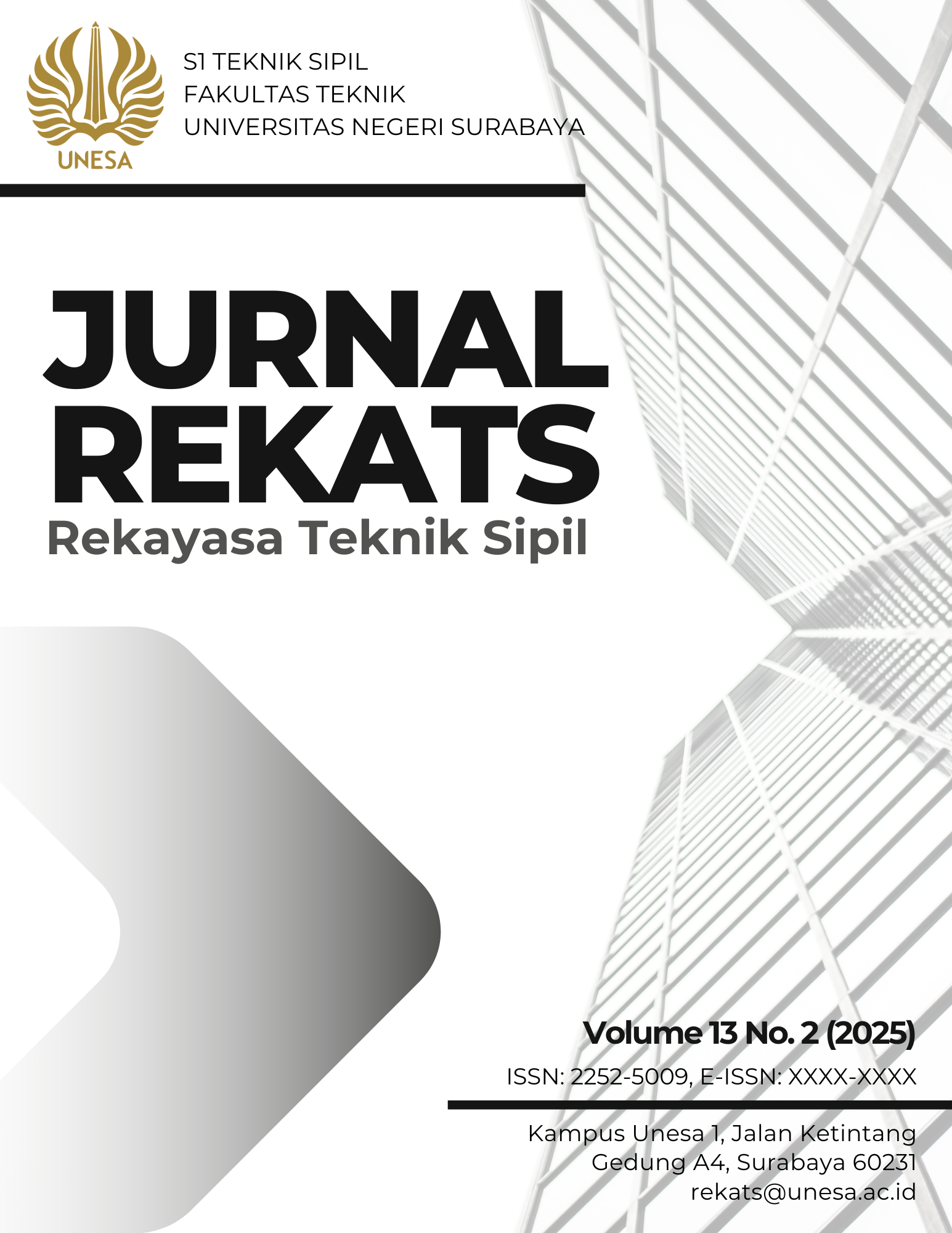PASTEURIA, BACILLUS SPHAERICUS, AND BACILLUS SUBTILIS BACTERIA ADDITION EFFECT ON SELF-HEALING CONCRETE COMPRESSIVE STRENGTH
DOI:
https://doi.org/10.26740/rekats.v13n02.p320-327Keywords:
Self Healing Concrete, Pasteuria, Bacillus Sphaericus, Bacillus SubtillisAbstract
Concrete is the most commonly used material for building houses due to its low production cost, strength,
and durability. One of the most frequent issues encountered is cracking, which results in additional repair costs.
An alternative solution is to incorporate bacteria such as Pasteuria, Bacillus Sphaericus, and Bacillus Subtilis
into the concrete structure. This research used a quantitative method conducted in a laboratory by controlling the
test objects. Based on previous studies, the addition of these bacteria involves preparing large containers as
concrete chambers. The concrete used is that which has undergone compressive strength testing in the laboratory,
with data obtained at the 28-day curing period. Data collection was carried out by allocating each type of bacteria
to six specimens per container. In one container, four bacterial isolates were mixed with 72 liters of water and six
prepared specimens. The specimens were then left until the surface dried. The compressive strength test was
conducted again, and the results were compared with the initial test results to determine the percentage of
compressive strength recovery. The study concluded that Bacillus Subtilis was the most effective bacteria among
the three in optimizing concrete compressive strength recovery.
Downloads
References
Algaifi, H. A., Bakar, S. A., Sam, A. R. M., Abidin, A. R. Z., Shahir, S., & AL-Towayti, W. A. H. (2018). Numerical modeling for crack self-healing concrete by microbial calcium carbonate. Construction and Building Materials, 189, 816–824.
ARIFIN, I. A., & Wardhono, A. (2018). Pengaruh subtitusi limbah marmer pada fly ash terhadap kuat tekan dan porositas beton geopolimer pada molaritas 10m. Jurnal REKATS Universitas Negeri Surabaya, 16–23.
Gumelar, F., & Nuraini, R. (2020). Bakteri Bacillus Subtilis Sebagai Agen Self Healing Concrete Dengan Variasi Persentase Dan Nilai PH. Jurnal Rekayasa, 10(2), 142–152.
Haikal, M., Asyifa, C. N., & Aulia, T. B. (2024). Pengaruh Bakteri Staphylococcus sp. Terhadap Kuat Tekan Beton Mutu Tinggi pada Self-Healing Concrete. Journal of The Civil Engineering Student, 6(2), 36–42.
Herlambang, W., & Saraswati, A. (2017). Bio Concrete: Self-healing concrete, aplikasi mikroorganisme sebagai solusi pemeliharaan infrastruktur rendah biaya. Simposium II UNIID 2017, 2(1), 520–524.
Khaliq, W., & Ehsan, M. B. (2016). Crack healing in concrete using various bio influenced self-healing techniques. Construction and Building Materials, 102, 349–357.
Kim, H. J., Eom, H. J., Park, C., Jung, J., Shin, B., Kim, W., Chung, N., Choi, I.-G., & Park, W. (2016). Calcium carbonate precipitation by Bacillus and Sporosarcina strains isolated from concrete and analysis of the bacterial community of concrete. Journal of Microbiology and Biotechnology, 26(3), 540–548.
Ningsih, M. D. S., Linda, T. M., & Fibriarti, B. L. (2018). Isolasi dan keragaman bakteri ureolitik lokal riau yang berpotensi sebagai campuran beton. Al-Kauniyah, 11(1), 57–63.
Rochani, I., Prasetyo, A., & Kurniawan, A. (2016). Pemanfaatan Batu Apung (Pumice) Lombok dan Bakteri (Baccillus Subtilis) sebagai Agent Perbaikan Kerusakan Retak Pada Beton. Majalah Geografi Indonesia, 30(1), 49–57.
Seifan, M., & Berenjian, A. (2019). Microbially induced calcium carbonate precipitation: A widespread phenomenon in the biological world. Applied Microbiology and Biotechnology, 103, 4693–4708.
Tang, Y., & Xu, J. (2021). Application of microbial precipitation in self-healing concrete: A review on the protection strategies for bacteria. Construction and Building Materials, 306, 124950.
Vijay, K., Murmu, M., & Deo, S. V. (2017). Bacteria based self healing concrete–A review. Construction and Building Materials, 152, 1008–1014.
Zou, K., Wang, L., & Ueda, T. (2025). A Time-Varying Model for Predicting Crack Closure in Microbial Self-healing Concrete after Incorporating Encapsulated Agent. Journal of Building Engineering, 112748.
Downloads
Published
Issue
Section
 Abstract views: 103
,
Abstract views: 103
, PDF Downloads: 0
PDF Downloads: 0





